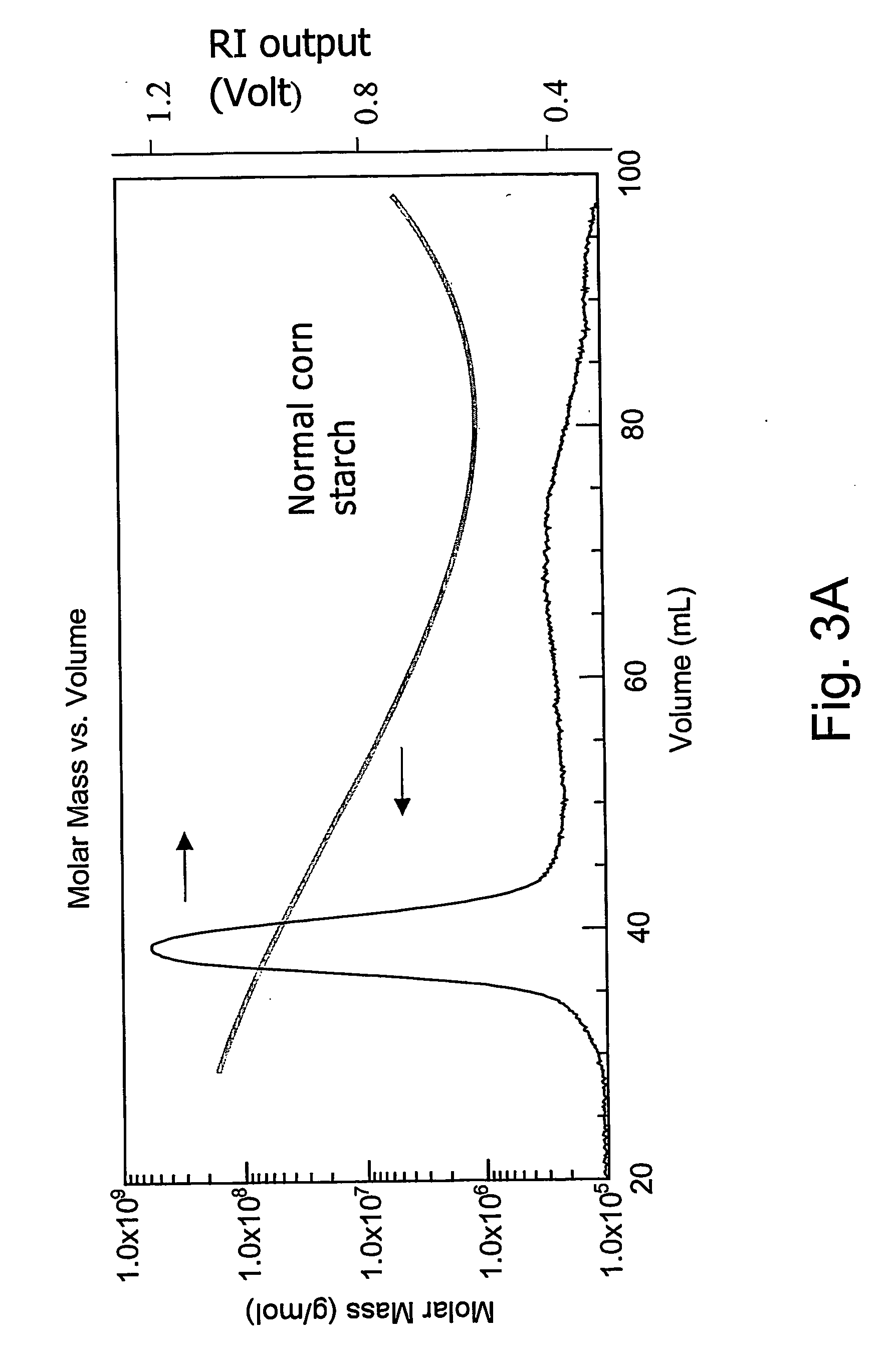Slowly digestible starch
a technology of slow-dissolving starch and slow-dissolving technology, which is applied in the field of slow-dissolving starch, can solve the problems that no commercial product of slow-dissolving starch is currently available on the market, and achieve the effects of slow-dissolving starch, slow-dissolving starch, and slow-dissolving starch
- Summary
- Abstract
- Description
- Claims
- Application Information
AI Technical Summary
Benefits of technology
Problems solved by technology
Method used
Image
Examples
example 1
Preparation Of Slowly-Digesting Starch
[0078] Normal corn starch (˜25% amylose, 5% by weight in water) was heated to over 80° C. with stirring to disperse the starch and begin gelatinization and thereafter gelatinized in an autoclave (at ˜120° C.) for 15 minutes. The gelatinized starch solution is cooled to and stored at 4° C. for 12 hours to allow the starch to retrograde. The starch solution is then warmed to 37° C., and partially digested using alpha-amylase [porcine pancreas alpha-amylase (Sigma A-3176) containing 15.4 units / mg of solid at pH=6.9; a unit being defined as the amount of enzyme that will liberate 1.0 mg of maltose from starch in 3 min at pH 6.9 at 20° C.; added at 15 units / g starch, 30 units / g starch, or 45 units / g starch]. Partial digestion was accomplished by treating the starch solution (with pH adjusted to 6.9, starch solution was made up to 0.0625 mM sodium glycerophosphate-HCl, 1.5625 mM NaCl and 0.3125 mM CaCl2) for 1-4 hours with alpha-amylase. Enzyme actio...
example 2
In Vitro Procedure Of Testing Cooked Starch Digestion
[0080] Starch (500 mg) was cooked in 5 mL distilled water for 10 minutes and cooled to 37° C. Buffer (20 mL, 1 mM sodium glycerophosphate-HCL, pH 6.9, 25 mM NaCl, 5 mM CaCl2) was then added to the cooked starch. The solution was equilibrated at 37° C., and 150 Units of alpha-amylase were added [0.5 mL, 12.3 units / mg of porcine pancreas alpha-amylase (Sigma A-3176) containing 15.4 units / mg of solid at pH=6.9; one unit will liberate 1.0 mg of maltose from starch in 3 min at pH 6.9 at 20° C.). Enzyme hydrolysis was carried out at 37° C. and 0.5 mL aliquots of hydrolyzed solutions were withdrawn at selected times. The equivalent reducing sugar value of maltose was determined using the Nelson-Somogyi method for determination of reducing sugars (Chaplin, M. F., and Kennedy, J. F. (1994) Carbohydrate Analysis—A practical Approach. 2nd Edition. pp 4. Oxford University Press Inc., Oxford, UK).
[0081] The extent of hydrolysis was determine...
example 3
In Vivo Assay Of Acute Glycemic Response To Cooked Treated Starch
[0083] Starch samples (10% by weight in water) were cooked in boiling water for 10 min and cooled at room temperature for 1 hour. Sprague / Dawley rats (age of 44-48 days and about 175-199 gram) were fed 2.3 mL (10% water starch solution) of a cooked starch sample and blood samples were drawn at selected times after feeding. Profiles are of blood glucose levels over 180 min after ingestion of starches (by oral gravage). Blood glucose levels were determined by the calorimetric method, using a Cobas Mira Plus autoanalyzer (Roche Diagnostics, Mannheim, German.) (See: A.Gokcel, H. Karakose, E. M. Ertorer, N. Tanaci, N. B. Tutuncu and N. Guvener (2001) “Effects of Sibutramine in Obese Female Subjects With Type 2 Diabetes and Poor Blood Glucose Control”Diabetes Care 24:1957-1960.)
[0084]FIG. 2 is a graph comparing glucose concentration as a function of time after oral gravage feeding of normal cooked starch and a sample of al...
PUM
| Property | Measurement | Unit |
|---|---|---|
| Temperature | aaaaa | aaaaa |
| Temperature | aaaaa | aaaaa |
| Temperature | aaaaa | aaaaa |
Abstract
Description
Claims
Application Information
 Login to View More
Login to View More - R&D
- Intellectual Property
- Life Sciences
- Materials
- Tech Scout
- Unparalleled Data Quality
- Higher Quality Content
- 60% Fewer Hallucinations
Browse by: Latest US Patents, China's latest patents, Technical Efficacy Thesaurus, Application Domain, Technology Topic, Popular Technical Reports.
© 2025 PatSnap. All rights reserved.Legal|Privacy policy|Modern Slavery Act Transparency Statement|Sitemap|About US| Contact US: help@patsnap.com



